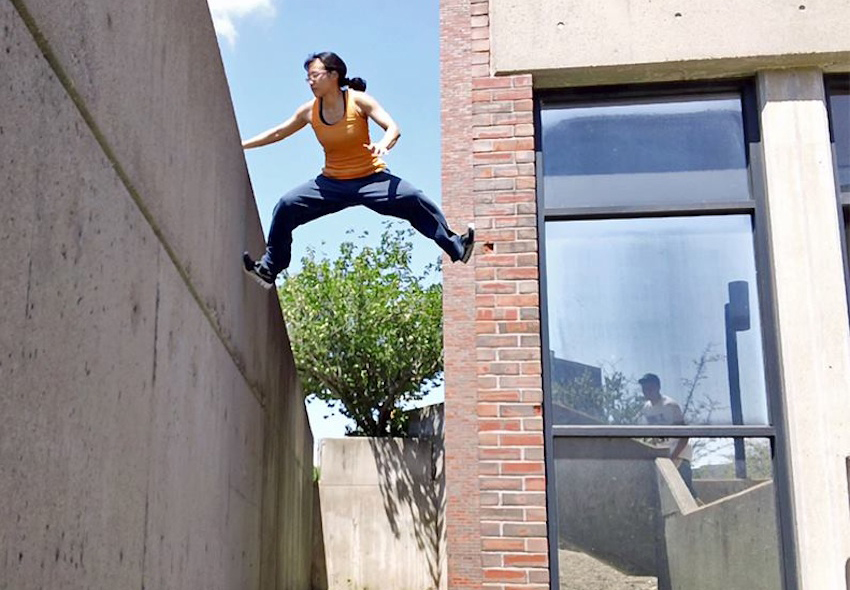What is Parkour?

Hai in action. Photos provided
To some of us, being efficient means not getting caught behind a group of school children or tourists in line for the T. To parkour athletes, it’s about a whole lot more than that. “Parkour is a physical discipline that involves overcoming obstacles in one’s environment using the human body without any additional tools or equipment,” explains Jackie Hai, a community organizer at New England Parkour. “Parkour is also just a way of looking at your environment through a different lens. You start to see opportunities where once there were obstacles.”
So what, exactly, does that mean? Think of it as turning your surroundings into a physically-challenging obstacle course. Typical parkour motions could be scaling walls, vaulting and swinging over tables and other obstacles, and jumping over things in your path. Parkour is normally a non-competitive sport and can be practiced anywhere—even walking down the street—but there are also a number of gyms in the Boston area offering classes for first-timers all the way up to experts.
The typical parkour athlete trains using body weight exercises like pull-ups and push-ups, weight training, and, of course, learning the specific parkour movements, which, Hai says, makes it a great workout. “It doesn’t just train one group of muscles; it trains all of the muscles, and also balance, coordination, agility, quick thinking, and adapting yourself to changing situations. It’s a mental workout and it’s a physical workout.”
Dylan Polin of New England Sports Academy in Westwood offers an even simpler definition for parkour. “The strict definition of it is you get from point A to point B as quickly as possible,” he says. That explanation may surprise you if you’ve seen the crazy difficult-looking stunts performed in YouTube videos labeled as parkour, but Polin says those tricks may actually fall under free running, a sport closely related to parkour and one he teaches at New England Sports Academy.
“Inefficient moves like flips and spins and traveling backwards wouldn’t constitute as parkour because it’s not trying to get to that point B,” Polin explains. “Parkour is efficiency, and free running is where people start to take the moves laid out by parkour and make them a little more expressive, so now you’re working with flash.”
Parkour also has a mental component, Polin says. “It’s conquering fears, and it’s learning to master that little voice in your head saying, ‘No, I shouldn’t be running at this inanimate object,'” he says.

Based on exercises and tactics developed for the French army, parkour reached its current iteration in the 1990s and has only grown in popularity since. “At first, there were these classes that were in existing gymnastics gyms, or even rock climbing gyms,” Hai says. “Eventually, as more traction was gained, these parkour-specific facilities started opening up across the country.” Now, Hai says, the New England Parkour website alone has close to 2,000 registered members.
This growth is at least partially attributable to mainstream television shows like Ninja Warrior, in which athletes—many of them parkour “traceurs,” as they’re called—complete an insanely difficult obstacle course, as well as the sudden ubiquitousness of parkour-esque extreme races and mud runs. But Hai is quick to point out that, while she is glad parkour is reaching the mainstream, the typical depiction of the sport isn’t a totally accurate portrayal. “Parkour isn’t just what you see in the YouTube videos or the big action movies with all the crazy stunts,” she says. “That’s sort of the glamorized version of it in the mainstream media.”
And while those who associate parkour only with that glamorized representation may think it’s only for the extreme athlete, both Polin and Hai say that the sport is open to anybody. “Anybody can do it. You’d be surprised at how quickly your body adapts to moving around,” Polin says, adding that the community stresses safe skill development and advancement and offers introductory classes that teach the fundamentals. “It’s what our bodies are kind of meant to be doing. Maybe not all the crazy flips, but it’s using our bodies to their full potential.”


